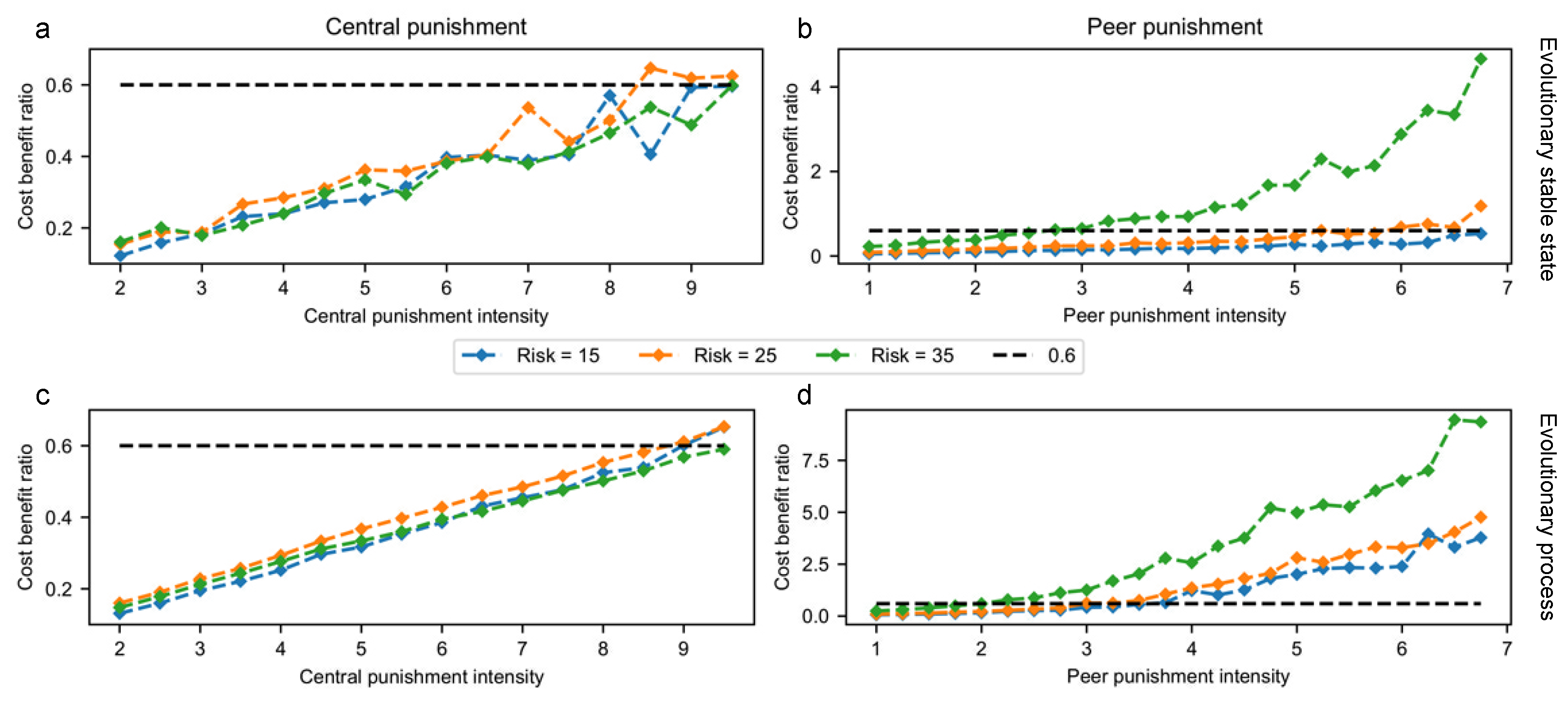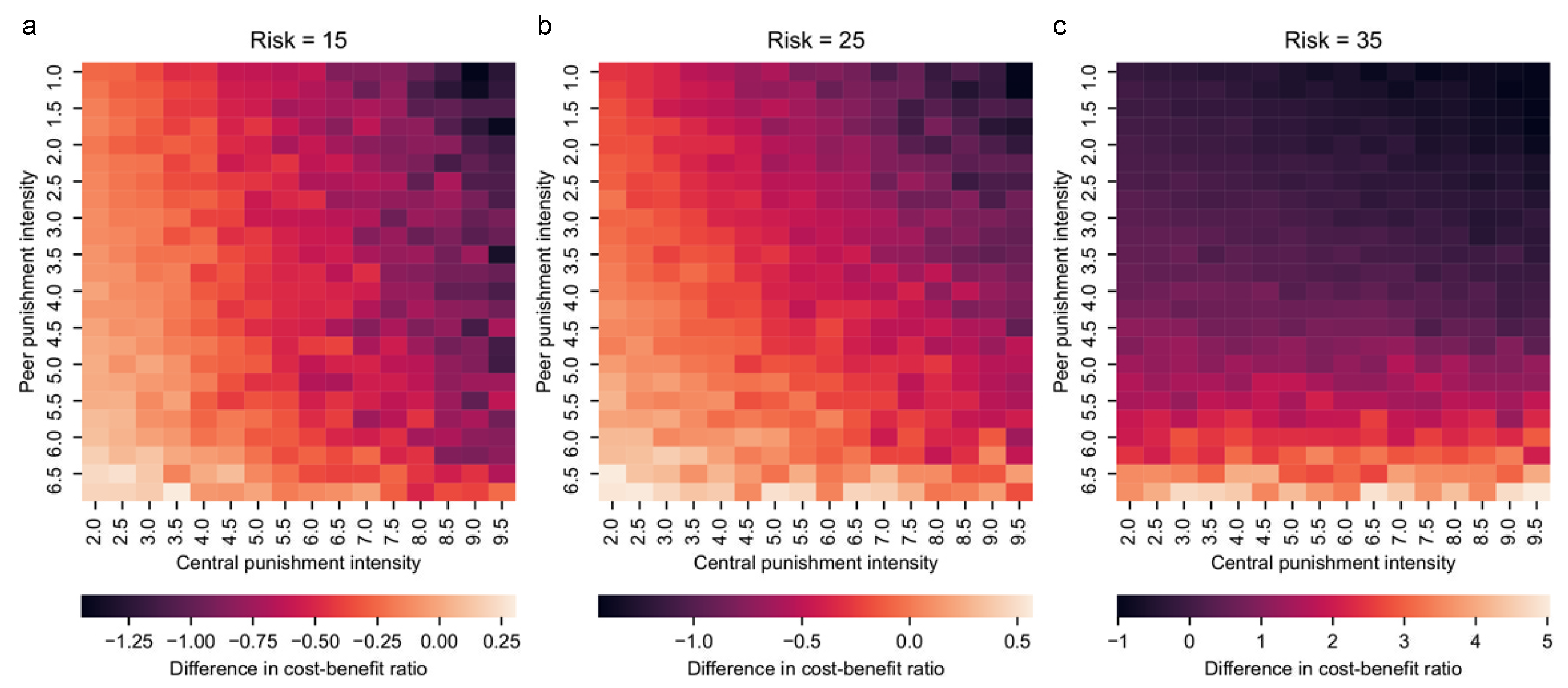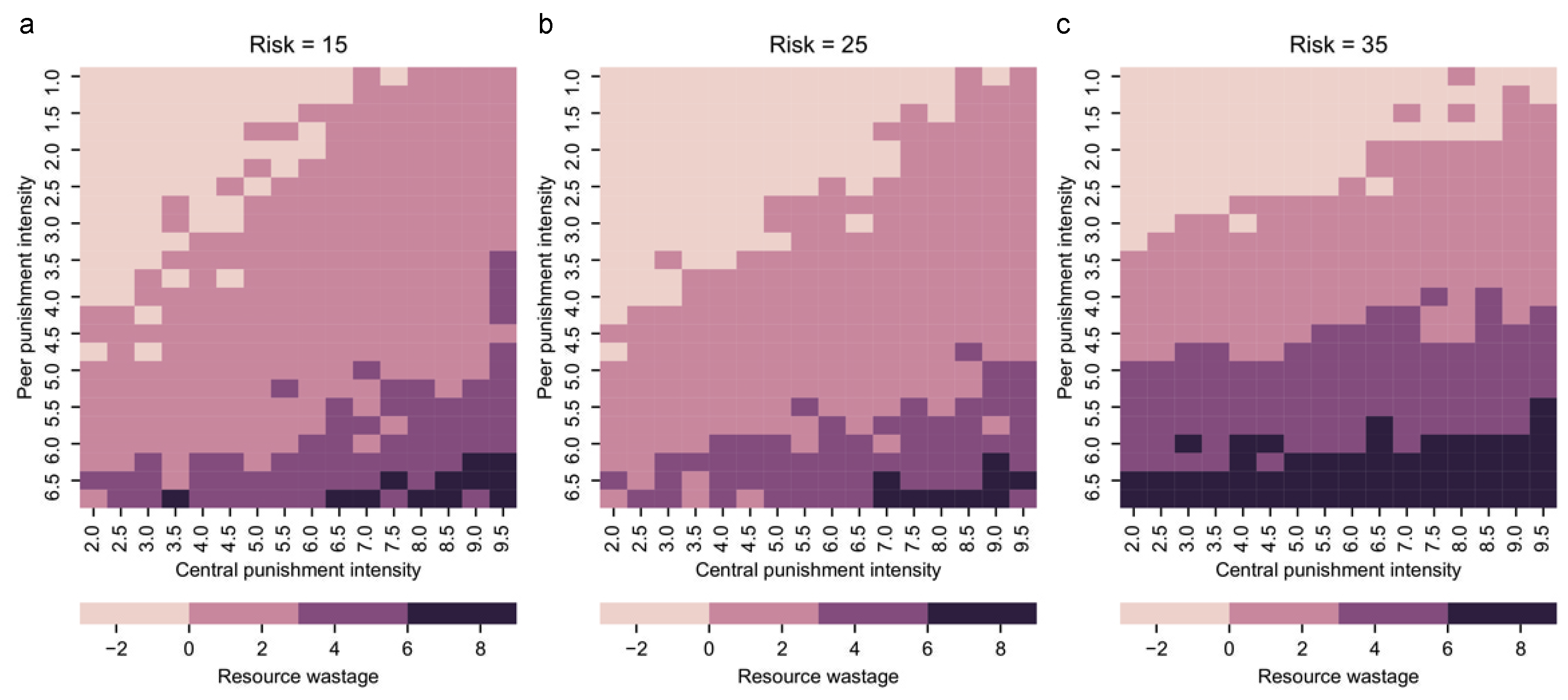Authority or Autonomy? Exploring Interactions between Central and Peer Punishments in Risk-Resistant Scenarios
Abstract
:1. Introduction
2. Materials and Methods
Model and Assumptions
- Individuals are rational and their behavior is motivated by maximizing their own gains.
- Individuals choose their own strategies from the strategy space and have the ability to learn strategies from other individuals.
- Individuals as a whole are exposed to risky scenarios, which means that all individuals lose a portion of their gains if the risk is not successfully resisted.
- Collaborator who does not enforce punishment (C): contributes resources to the group.
- Collaborator who supports central punishment (CP): contributes funds to establish a central enforcement institution and contributes resources to the group.
- Collaborator who enforces peer punishment (PP): pays the cost to punish free-riders and contributes resources to the group.
- Defector who does not enforce punishment (D): does not contribute resources.
3. Results
3.1. Promotion of Group Collaboration
- When comparing the performance of punishment under different risks, we can find that the greater the risk is, the more noticeable enhancement of collaboration by peer punishment with a significantly higher percentage of PP strategies.
- In contrast, the boosting effect of central punishment on the collaboration rate is relatively fixed and does not vary much with different risk levels.
- To summarize, compared with central punishment, peer punishment promotes collaboration more significantly under different risks, and it shows even greater power under high-level risks.
3.2. Characteristics of Central Punishment and Peer Punishment
3.3. Analysis on Cost–Benefit Ratio
3.4. Resource Wastage by the Punishments
4. Discussion
5. Conclusions
Author Contributions
Funding
Institutional Review Board Statement
Informed Consent Statement
Data Availability Statement
Conflicts of Interest
References
- Zafar, M.W.; Shahbaz, M.; Hou, F.; Sinha, A. From nonrenewable to renewable energy and its impact on economic growth: The role of research & development expenditures in Asia-Pacific Economic Cooperation countries. J. Clean. Prod. 2019, 212, 1166–1178. [Google Scholar] [CrossRef]
- Gusarova, S. Role of China in the development of trade and FDI cooperation with BRICS countries. China Econ. Rev. 2019, 57, 101271. [Google Scholar] [CrossRef]
- Thube, S.D.; Delzeit, R.; Henning, C.H. Economic gains from global cooperation in fulfilling climate pledges. Energy Policy 2022, 160, 112673. [Google Scholar] [CrossRef]
- Lin, B.; Bega, F. China’s Belt & Road Initiative coal power cooperation: Transitioning toward low-carbon development. Energy Policy 2021, 156, 112438. [Google Scholar] [CrossRef]
- Stellingwerf, H.M.; Laporte, G.; Cruijssen, F.C.; Kanellopoulos, A.; Bloemhof, J.M. Quantifying the environmental and economic benefits of cooperation: A case study in temperature-controlled food logistics. Transp. Res. Part Transp. Environ. 2018, 65, 178–193. [Google Scholar] [CrossRef]
- de Moraes Achcar, H. South-South cooperation and the re-politicization of development in health. World Dev. 2022, 149, 105679. [Google Scholar] [CrossRef]
- Alandijany, T.A.; Faizo, A.A.; Azhar, E.I. Coronavirus disease of 2019 (COVID-19) in the Gulf Cooperation Council (GCC) countries: Current status and management practices. J. Infect. Public Health 2020, 13, 839–842. [Google Scholar] [CrossRef]
- Guldbrandsson, K.; Bremberg, S. Cross-sectoral cooperation at the ministerial level in three Nordic countries—With a focus on health inequalities. Soc. Sci. Med. 2020, 256, 112999. [Google Scholar] [CrossRef]
- Li, X.; Molleman, L.; van Dolder, D. Do descriptive social norms drive peer punishment? Conditional punishment strategies and their impact on cooperation. Evol. Hum. Behav. 2021, 42, 469–479. [Google Scholar] [CrossRef]
- Shinada, M.; Yamagishi, T. Punishing free riders: Direct and indirect promotion of cooperation. Evol. Hum. Behav. 2007, 28, 330–339. [Google Scholar] [CrossRef] [Green Version]
- Yan, R.; Peng, L.; Xie, Y.; Wang, X. Rough Set-Game Theory Information Mining Model Considering Opponents’ Information. Electronics 2022, 11, 244. [Google Scholar] [CrossRef]
- Számadó, S.; Balliet, D.; Giardini, F.; Power, E.A.; Takács, K. The language of cooperation: Reputation and honest signalling. Philos. Trans. R. Soc. Biol. Sci. 2021, 376, 2020028. [Google Scholar] [CrossRef] [PubMed]
- Szekely, A.; Lipari, F.; Antonioni, A.; Paolucci, M.; Sánchez, A.; Tummolini, L.; Andrighetto, G. Evidence from a long-term experiment that collective risks change social norms and promote cooperation. Nat. Commun. 2021, 12, 5452. [Google Scholar] [CrossRef] [PubMed]
- Molho, C.; Tybur, J.M.; Lange, P.A.V.; Balliet, D. Direct and indirect punishment of norm violations in daily life. Nat. Commun. 2020, 11, 1–9. [Google Scholar] [CrossRef]
- Ohtsuki, H.; Iwasa, Y.; Nowak, M.A. Indirect reciprocity provides only a narrow margin of efficiency for costly punishment. Nature 2009, 457, 79–82. [Google Scholar] [CrossRef]
- Capraro, V.; Perc, M. Mathematical foundations of moral preferences. J. R. Soc. Interface 2021, 18, 20200880. [Google Scholar] [CrossRef]
- Wu, J.J.; Ji, T.; He, Q.Q.; Du, J.; Mace, R. Cooperation is related to dispersal patterns in Sino-Tibetan populations. Nat. Commun. 2015, 6, 8693. [Google Scholar] [CrossRef]
- Peysakhovich, A.; Nowak, M.A.; Rand, D.G. Humans display a ‘cooperative phenotype’ that is domain general and temporally stable. Nat. Commun. 2014, 5, 4939. [Google Scholar] [CrossRef]
- Alós-Ferrer, C.; García-Segarra, J.; Ritschel, A. Generous with individuals and selfish to the masses. Nat. Hum. Behav. 2021, 6, 88–96. [Google Scholar] [CrossRef]
- Kim, M.; Choi, J.K.; Baek, S.K. Win-Stay-Lose-Shift as a self-confirming equilibrium in the iterated Prisoner’s Dilemma. Proc. R. Soc. Biol. Sci. 2021, 288, 20211021. [Google Scholar] [CrossRef]
- McAuliffe, W.H.; Forster, D.E.; Pedersen, E.J.; McCullough, M.E. Experience with anonymous interactions reduces intuitive cooperation. Nat. Hum. Behav. 2018, 2, 909–914. [Google Scholar] [CrossRef] [PubMed]
- Podder, S.; Righi, S.; Pancotto, F. Reputation and punishment sustain cooperation in the optional public goods game. Philos. Trans. R. Soc. Biol. Sci. 2021, 376, 20200293. [Google Scholar] [CrossRef] [PubMed]
- Rand, D.G.; Nowak, M.A. The evolution of antisocial punishment in optional public goods games. Nat. Commun. 2011, 2, 1–7. [Google Scholar] [CrossRef] [PubMed]
- Semmann, D.; Krambeck, H.J.; Milinski, M. Volunteering leads to rock-paper-scissors dynamics in a public goods game. Nature 2003, 425, 390–393. [Google Scholar] [CrossRef]
- Fehr, E.; Ga, S. Altruistic punishment in humans. Nature 2002, 415, 137–140. [Google Scholar] [CrossRef]
- Lindig-León, C.; Schmid, G.; Braun, D.A. Bounded rational response equilibria in human sensorimotor interactions. Proc. R. Soc. Biol. Sci. 2021, 288. [Google Scholar] [CrossRef]
- Hilbe, C.; Röhl, T.; Milinski, M. Extortion subdues human players but is finally punished in the prisoner’s dilemma. Nat. Commun. 2014, 5, 3976. [Google Scholar] [CrossRef]
- Radzvilavicius, A.L.; Kessinger, T.A.; Plotkin, J.B. Adherence to public institutions that foster cooperation. Nat. Commun. 2021, 12, 3567. [Google Scholar] [CrossRef]
- Samuni, L.; Crockford, C.; Wittig, R.M. Group-level cooperation in chimpanzees is shaped by strong social ties. Nat. Commun. 2021, 12, 539. [Google Scholar] [CrossRef]
- Sun, W.; Liu, L.; Chen, X.; Szolnoki, A.; Vasconcelos, V.V. Combination of institutional incentives for cooperative governance of risky commons. iScience 2021, 24, 102844. [Google Scholar] [CrossRef]
- Gross, J.; Veistola, S.; Dreu, C.K.D.; Dijk, E.V. Self-reliance crowds out group cooperation and increases wealth inequality. Nat. Commun. 2020, 11, 5161. [Google Scholar] [CrossRef] [PubMed]
- Akçay, E. Collapse and rescue of cooperation in evolving dynamic networks. Nat. Commun. 2018, 9, 2629. [Google Scholar] [CrossRef] [PubMed]
- Fotouhi, B.; Momeni, N.; Allen, B.; Nowak, M.A. Conjoining uncooperative societies facilitates evolution of cooperation. Nat. Hum. Behav. 2018, 2, 492–499. [Google Scholar] [CrossRef] [PubMed]
- Wang, Z.; Jusup, M.; Shi, L.; Lee, J.H.; Iwasa, Y.; Boccaletti, S. Exploiting a cognitive bias promotes cooperation in social dilemma experiments. Nat. Commun. 2018, 9, 2954. [Google Scholar] [CrossRef] [PubMed]
- Nowak, M.A. Five rules for the evolution of cooperation. Science 2006, 314, 1560–1563. [Google Scholar] [CrossRef]
- Nockur, L.; Pfattheicher, S.; Keller, J. Different punishment systems in a public goods game with asymmetric endowments. J. Exp. Soc. Psychol. 2021, 93, 104096. [Google Scholar] [CrossRef]
- Chen, X.; Cao, J.; Kumar, S. Government regulation and enterprise decision in China remanufacturing industry: Evidence from evolutionary game theory. Energy Ecol. Environ. 2021, 6, 148–159. [Google Scholar] [CrossRef]
- Lohse, J.; Waichman, I. The effects of contemporaneous peer punishment on cooperation with the future. Nat. Commun. 2020, 11, 1815. [Google Scholar] [CrossRef]
- Molleman, L.; Kölle, F.; Starmer, C.; Gächter, S. People prefer coordinated punishment in cooperative interactions. Nat. Hum. Behav. 2019, 3, 1145–1153. [Google Scholar] [CrossRef]
- Rockenbach, B.; Milinski, M. The efficient interaction of indirect reciprocity and costly punishment. Nature 2006, 444, 718–723. [Google Scholar] [CrossRef]
- Alventosa, A.; Antonioni, A.; Hernández, P. Pool punishment in public goods games: How do sanctioners’ incentives affect us? J. Econ. Behav. Organ. 2021, 185, 513–537. [Google Scholar] [CrossRef]
- Sasaki, T.; Uchida, S.; Chen, X. Voluntary rewards mediate the evolution of pool punishment for maintaining public goods in large populations. Sci. Rep. 2015, 5, 8917. [Google Scholar] [CrossRef]
- Schoenmakers, S.; Hilbe, C.; Blasius, B.; Traulsen, A. Sanctions as honest signals—The evolution of pool punishment by public sanctioning institutions. J. Theor. Biol. 2014, 356, 36–46. [Google Scholar] [CrossRef]
- Hu, K.; Tao, Y.; Ma, Y.; Shi, L. Peer pressure induced punishment resolves social dilemma on interdependent networks. Sci. Rep. 2021, 11, 15792. [Google Scholar] [CrossRef]
- Ozono, H.; Kamijo, Y.; Shimizu, K. The role of peer reward and punishment for public goods problems in a localized society. Sci. Rep. 2020, 10, 8211. [Google Scholar] [CrossRef]
- Przepiorka, W.; Diekmann, A. Individual heterogeneity and costly punishment: A volunteer’s dilemma. Proc. R. Soc. Biol. Sci. 2013, 280, 1759. [Google Scholar] [CrossRef]
- Bruhin, A.; Janizzi, K.; Thöni, C. Uncovering the heterogeneity behind cross-cultural variation in antisocial punishment. J. Econ. Behav. Organ. 2020, 180, 291–308. [Google Scholar] [CrossRef]
- Sulaymon, I.D.; Zhang, Y.; Hu, J.; Hopke, P.K.; Zhang, Y.; Zhao, B.; Xing, J.; Li, L.; Mei, X. Evaluation of regional transport of PM2.5 during severe atmospheric pollution episodes in the western Yangtze River Delta, China. J. Environ. Manag. 2021, 293, 112827. [Google Scholar] [CrossRef]
- Caro-Borrero, A.; Carmona-Jiménez, J.; Figueroa, F. Water resources conservation and rural livelihoods in protected areas of central Mexico. J. Rural. Stud. 2020, 78, 12–24. [Google Scholar] [CrossRef]
- Ho, C.C.; Hung, S.C.; Ho, W.C. Effects of short- and long-term exposure to atmospheric pollution on COVID-19 risk and fatality: Analysis of the first epidemic wave in northern Italy. Environ. Res. 2021, 199, 111293. [Google Scholar] [CrossRef]
- Tonnoir, A.; Ciotir, I.; Scutariu, A.L.; Dospinescu, O. A Model for the Optimal Investment Strategy in the Context of Pandemic Regional Lockdown. Mathematics 2021, 9, 58. [Google Scholar] [CrossRef]
- Yan, H.; Wei, H.; Wei, M. Exploring Tourism Recovery in the Post-COVID-19 Period: An Evolutionary Game Theory Approach. Sustainability 2021, 13, 9162. [Google Scholar] [CrossRef]
- Huang, S.; Liu, H. Impact of COVID-19 on stock price crash risk: Evidence from Chinese energy firms. Energy Econ. 2021, 101, 105431. [Google Scholar] [CrossRef]
- Spotswood, E.N.; Benjamin, M.; Stoneburner, L.; Wheeler, M.M.; Beller, E.E.; Balk, D.; McPhearson, T.; Kuo, M.; McDonald, R.I. Nature inequity and higher COVID-19 case rates in less-green neighbourhoods in the United States. Nat. Sustain. 2021, 4, 1092–1098. [Google Scholar] [CrossRef]
- Herrmann, B.; Thöni, C.; Gächter, S. Antisocial Punishment Across Societies. Science 2008, 319, 1362–1367. [Google Scholar] [CrossRef]






Publisher’s Note: MDPI stays neutral with regard to jurisdictional claims in published maps and institutional affiliations. |
© 2022 by the authors. Licensee MDPI, Basel, Switzerland. This article is an open access article distributed under the terms and conditions of the Creative Commons Attribution (CC BY) license (https://creativecommons.org/licenses/by/4.0/).
Share and Cite
Qian, J.; Sun, X.; Zhang, T.; Chai, Y. Authority or Autonomy? Exploring Interactions between Central and Peer Punishments in Risk-Resistant Scenarios. Entropy 2022, 24, 1289. https://doi.org/10.3390/e24091289
Qian J, Sun X, Zhang T, Chai Y. Authority or Autonomy? Exploring Interactions between Central and Peer Punishments in Risk-Resistant Scenarios. Entropy. 2022; 24(9):1289. https://doi.org/10.3390/e24091289
Chicago/Turabian StyleQian, Jun, Xiao Sun, Tongda Zhang, and Yueting Chai. 2022. "Authority or Autonomy? Exploring Interactions between Central and Peer Punishments in Risk-Resistant Scenarios" Entropy 24, no. 9: 1289. https://doi.org/10.3390/e24091289




